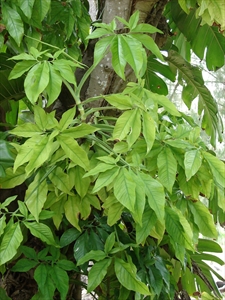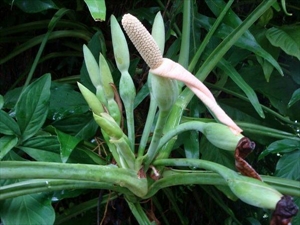Arrowhead vine. It is also known as American evergreen, African evergreen, five fingers.
Pacific Pests, Pathogens and Weeds - Online edition
Pacific Pests, Pathogens & Weeds
Arrowhead vine (494)
Syngonium podophyllum. It is a member of the Araceae.
Asia, Africa, North (Florida, Hawaii), South and Central America, the Caribbean, Oceania. It is recorded from Australia, American Samoa, Cook Islands, Federated States of Micronesia, French Polynesia, Guam, New Caledonia, Niue, Palau, and Solomon Islands. It is a native of Central and South America, and the Caribbean.
A fast-growing, perennial, creeping or climbing epiphyte (a plant that grows on another, and not necessarily parasitic), growing under shade in mostly fertile sandy or loamy soil. Invasive in wide range of situations: disturbed and undisturbed forests, forest margins, wastelands, wetlands, roadsides, agricultural land in both sub-tropical and tropical environments (Photo 1). Capable of smothering mature trees and preventing the growth of native vegetation in the understory. It occurs from sea level to 1000 m.
A vine growing to 10 m, with stems 1-2 cm diameter, cylindrical, dull-greenish-grey, developing aerial roots with age helping plants to climb. Juvenile lower leaves undivided, spear-shaped, often with white main veins and green between, but patterns vary greatly (Photo 2). Mature upper leaves divided into three leaflets at first, later increasing up to nine; leaf stalks, 15-60 cm (Photo 3). Flowers, six to nine, at the top of the plant, tubular, in leaf axils, each enclosed in a greenish modified leaf (the spathe) (Photo 4), opening to expose the male part (spadix), with female (pistillate) part remaining enclosed below. Fruits rare; if produced, they are red, with black seeds.
Spread locally is through creeping and climbing, as well as disposal of unwanted cuttings rooting wherever stems touch the ground. Stem pieces can also be spread in flood water, and even by mowing. Spread over longer distances by use as an ornamental. Flowers occur occasionally and more rarely seeds are produced. Seed has been reported from Hawaii, USA, and from Queensland, Australia.
In Australia, arrowhead vine is regarded as an environmental weed in Queensland where it crawls or climbs over native vegetation in moist shady areas with fertile soils. It is also thought to be a potential environmental weed or 'sleeper weed' in other parts of northern and eastern Australia.
An important plant of the domestic and international trade in ornamental and landscape plants, with numerous varieties.
BIOSECURITY
The chances of introduction of arrowhead vine is high as it is commonly used as an ornamental and house plant in the sub-tropics and tropics. Countries not yet infested should consider all likely pathways for entry, and apply quarantine measures accordingly. Particular attention should be given to its ready availability on the Internet.
Syngonium podophyllum is on the Global Invasive Species Database (2021) of information on alien and invasive species that negatively impact biodiversity, managed by the Invasive Species Specialist Group of the IUCN Species Survival Commission: (http://www.iucngisd.org/gisd/speciesname/syngonium+podophyllum).
BIOLOGICAL CONTROL
Not a method recommended for Syngonium podophyllum.
CULTURAL CONTROL
- Physical & Mechanical:
- Hand-pulling is possible for isolated plants or small plantings.
- use strong gloves to avoid sap irritating the skin
- collect all root and stem pieces and burn them, otherwise they may resprout if left on or in the soil.
- Hand-pulling is possible for isolated plants or small plantings.
In Australia, minor use permits allow the use of the following systemic herbicides for the control of arrowhead vine: triclopyr; fluroxypyr; fluroxypyr + aminopyralid; metsulfuron-methyl; 2,4-D; glyphosate. Use the stem-scraping method for applying the herbicides. Scrape 10 cm stem with a knife to expose the sap wood, and then apply the herbicide with a paint brush. Follow-up treatments may be required.
--------------------
Note, EU approval to use glyphosate ends in December 2022; its use after that date is under discussion.
____________________
When using a pesticide, always wear protective clothing and follow the instructions on the product label, such as dosage, timing of application, and pre-harvest interval. Recommendations will vary with the crop and system of cultivation. Expert advice on the most appropriate herbicides to use should always be sought from local agricultural authorities.
AUTHOR Grahame Jackson
Information from CABI (2013) Syngonium podophyllum (arrowhead vine). Invasive Species Compendium. (https://www.cabi.org/isc/datasheet/52285); and Syngonium podophyllum (2009) Pacific Island Ecosystems at Risk (PIER) (http://www.hear.org/pier/species/syngonium_podophyllum.htm); and Arrowhead vine Syngonium podophyllum Schott, Araceae (2019) The State of Queensland, Department of Agriculture and Fisheries: (https://www.daf.qld.gov.au/__data/assets/pdf_file/0008/59948/arrowhead-vine.pdf); and Arrowhead vine (2020) Business Queensland. Queensland Government. (https://www.business.qld.gov.au/industries/farms-fishing-forestry/agriculture/land-management/health-pests-weeds-diseases/weeds-diseases/invasive-plants/other/arrowhead-vine); and from Syngonium Syngonium podophyllum. Weedidentificationtool. Brisbane City Council. (https://weeds.brisbane.qld.gov.au/weeds/syngonium#:~:text=Syngonium%20(Syngonium%20podophyllum)%20is%20regarded,of%20northern%20and%20eastern%20Australia). Photos 1&2. Forest & Kim Starr, Syngonium podophyllum leaves Lowes Garden Center, Kahului, Maui (Photo # starr-080103-1366). Photos 3&4 Konrad Englburger. Pohnpei, Federated States of Micronesia.
Produced with support from the Australian Centre for International Agricultural Research under project HORT/2016/185: Responding to emerging pest and disease threats to horticulture in the Pacific islands, implemented by the University of Queensland and the Secretariat of the Pacific Community.







